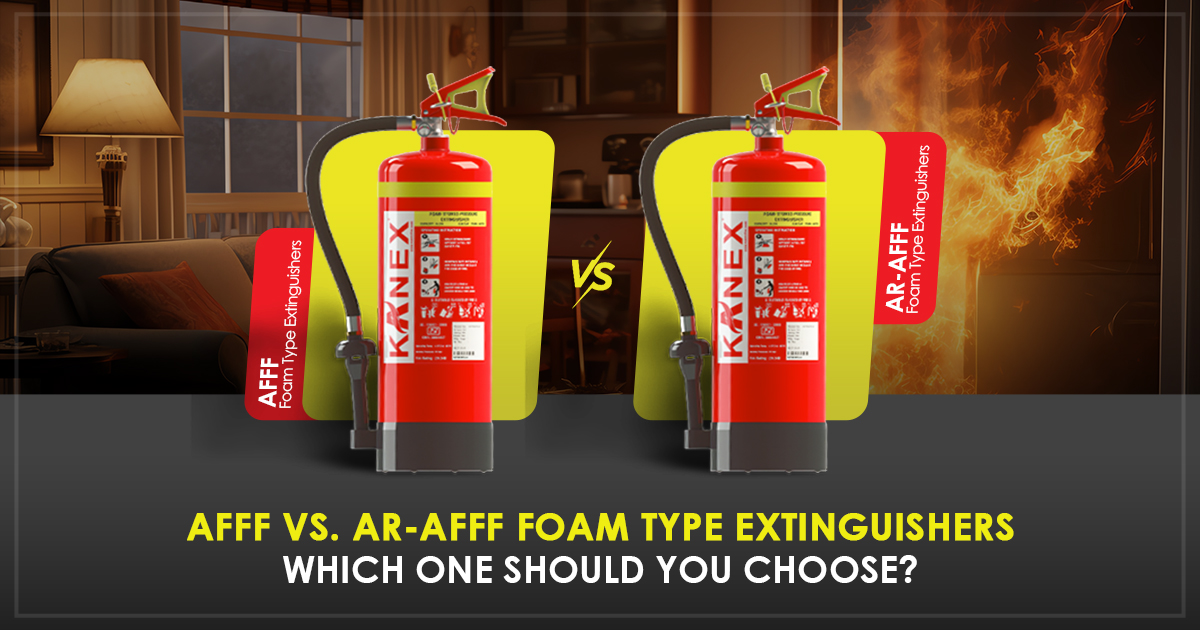AFFF vs. AR-AFF Foam Type Extinguishers – Which One Should You Choose?
- October 14, 2025
When it comes to fire safety, choosing the right foam extinguisher is crucial. Two of the most widely used types are AFFF (Aqueous Film Forming Foam) and AR-AFFF (Alcohol Resistant Aqueous Film Forming Foam).
Both are effective, but they serve different types of fires and operational conditions. Let’s explore how they differ and which one best suits your environment.
What Is an AFFF Fire Extinguisher and How Does It Work?
AFFF (Aqueous Film Forming Foam) fire extinguisher is designed for hydrocarbon-based fires such as petrol, diesel, or kerosene. It works by forming a thin aqueous film over the fuel surface, cutting off oxygen and smothering flames.
Item Codes: KFMSRQ-9, MMSRQ-9
- Best for: Hydrocarbon fires (Petrol, Diesel, Kerosene, etc.)
- Working principle: Forms a thin film over hydrocarbon fuels to smother flames and cut off oxygen.
- Limitations:
- Not effective on polar solvents (alcohol, acetone, etc.)
- Film weakens above 90°C fuel temperature
- Shorter burn-back resistance compared to AR-AFFF
Recommended for: Petrol pumps, warehouses, transport depots, and automobile workshops.
What Is an AR-AFFF Fire Extinguisher and When Should You Use It?
AR-AFFF (Alcohol Resistant Aqueous Film Forming Foam) fire extinguisher is formulated to fight both hydrocarbon and polar solvent fires. It contains a polysaccharide polymer that forms a strong, heat-resistant film even on alcohol-based fuels.
Item Codes: KFMSSHQ-9-AR, KFMSHQ-9-AR
- Best For: Both hydrocarbon and polar solvent fires.
- Working Principle: Forms a strong polysaccharide polymer film that resists dissolution even in alcohol-based fuels.
- Advantages Over AFFF:
- Universal application – works on both polar & non-polar fires
- Superior burn-back resistance & sealability
- Stable at high temperatures – ideal for deep-seated fires
- Longer foam stability = better cooling effect
Recommended for: Chemical plants, pharmaceutical industries, tank farms, aviation fuel storage, and high-risk solvent environments.
Comparison Between AFFF & AR-AFFF Fire Extinguisher
Watch this short demonstration showing how AFFF and AR-AFFF foam extinguishers perform on different types of fires. Notice the stronger film formation and longer burn-back resistance of AR-AFFF foam — making it the preferred choice for both hydrocarbon and polar solvent fires. Check the detailed comparison below to easily understand the differences between AFFF and AR-AFFF foam extinguishers.
| Sr. No. | Points | AFFF | AR-AFFF (AGFFF, ATC, ARF) | Remarks |
| 1 | Approvals | AFFF is ISI marked (IS 4989:2006) & UL–162 Marked | AR-AFFF is ISI marked (IS 4989: Part IV) & UL–162 | Both products have requisite approvals. |
| 2 | Fire on non-polar solvent | Thin film of fluoro surfactant forms over non polar solvent. | Thin film of fluoro surfactant forms over non polar solvent. | Both AFFF & AR-AFFF are effective on nonpolar hydrocarbon solvents. |
| 3 | Fire on polar solvent | No film is formed on polar (water-soluble) solvents. | A strong and insoluble film of polysaccharide is formed on a polar solvent. | AFFF is not suitable for polar solvents, whereas AR-AFFF works equally well even on polar solvents. |
| 4 | Vapour suppression | Only hydrocarbon vapours can be suppressed. | Vapours of polar and non-polar both can be suppressed. | Universal applications on any solvents. So no need to buy and store 2 types of foams. |
| 5 | Film Formation | The film-forming capacity diminishes beyond a fuel temperature of 90°C. | Polymeric film is not significantly affected by a rise in temperature. | AR-AFFF is best suited for hot & deep fire,s as tank fires. |
| 6 | Drainage | The film formed by AFFF Foam gets drained in a short time. | It remains stable on the fuel for a longer time and has slow drainage. | Slow drainage of AR-AFFF enables the foam to have a better cooling effect. |
| 7 | Burn-back Resistance Test of ISI | As per IS:4989:2006, the minimum burnback resistance time is 8 min. | As per IS:4989:Part IV, the minimum burn-back resistance time is 10 min. | AR-AFFF foam bubbles are robust and stronger to withstand high temperatures, so the burn back resistance of AR-AFFF is higher. |
| 8 | Sealability Test of UL | After the fire is extinguished, a sealability test is carried out for 9 min. | After the fire is extinguished, a sealability test is carried out for 15 min. | AR-AFFF exhibits better burn-back resistance. |
| 9 | Self-healing property | Self-healing characteristic is shown only at low fuel temperature over non-polar solvents. The film simply dissolves in polar solvents. | Self-healing characteristic is shown even at high fuel temperature on both non-polar as well as polar solvents. | Better self-healing characteristics of AR-AFFF enable the film to reappear even after it gets disturbed. |
Why Choose Kanex Foam Type Extinguishers?
- Certified to ISI & UL standards for reliability.
- Designed for fast knockdown, better coverage, and strong re-ignition resistance.
- Available in multiple sizes and capacities to suit diverse industrial and commercial needs.
Need Expert Advice?
Still unsure which fire extinguisher suits your site best? Contact Kanex Fire today for certified foam extinguishers tailored to your industrial needs.
Conclusion
While both AFFF and AR-AFFF extinguishers are effective in their own applications, AR-AFFF stands out for its versatility, reliability, and superior fire performance on both hydrocarbon and polar solvent fires. For businesses that demand all-around fire protection, Kanex AR-AFFF Foam Type Extinguishers offer the perfect balance of safety, certification, and long-term value — ensuring you’re always prepared for any fire emergency.






